SATURN VUE HYBRID 2009 Owners Manual
Manufacturer: SATURN, Model Year: 2009, Model line: VUE HYBRID, Model: SATURN VUE HYBRID 2009Pages: 346, PDF Size: 2.1 MB
Page 1 of 346

Seats and Restraint
System............................... 1-1
Head Restraints
.............. 1-2
Front Seats
.................... 1-3
Rear Seats
.................... 1-9
Safety Belts
..................1-10
Child Restraints
.............1-22
Airbag System
..............1-41
Restraint System
Check
......................1-56
Features and Controls...... 2-1
Keys
............................. 2-2
Doors and Locks
............ 2-6
Windows
........................ 2-9
Theft-Deterrent
Systems
...................2-10
Starting and Operating
Your Vehicle
.............2-14
Mirrors
.........................2-27
OnStar
®System
............2-29
Universal Home Remote
System
.....................2-32
Storage Areas
...............2-37
Instrument Panel............... 3-1
Instrument Panel
Overview
.................... 3-4
Climate Controls
............3-17
Warning Lights, Gages,
and Indicators
............3-22
Driver Information
Center (DIC)
.............3-36
Audio System(s)
............3-56
Driving Your Vehicle......... 4-1
Your Driving, the Road,
and the Vehicle
........... 4-1
Towing
........................4-22
Service and
Appearance Care............... 5-1
Service
.......................... 5-3
Fuel
.............................. 5-5
Checking Things Under
the Hood
.................... 5-9
Headlamp Aiming
..........5-33
Bulb Replacement
.........5-35Windshield Wiper Blade
Replacement
.............5-38
Tires
...........................5-38
Appearance Care
..........5-66
Vehicle Identi�cation
......5-74
Electrical System
...........5-74
Capacities and
Speci�cations
............5-81
Maintenance Schedule...... 6-1
Maintenance Schedule
..... 6-1
Customer Assistance
Information........................ 7-1
Customer Assistance and
Information
................. 7-1
Reporting Safety
Defects
.....................7-12
Vehicle Data Recording
and Privacy
...............7-14
Index....................................i-1
2009 Saturn VUE Green Line Hybrid Owner ManualM
ProCarManuals.com
Page 2 of 346
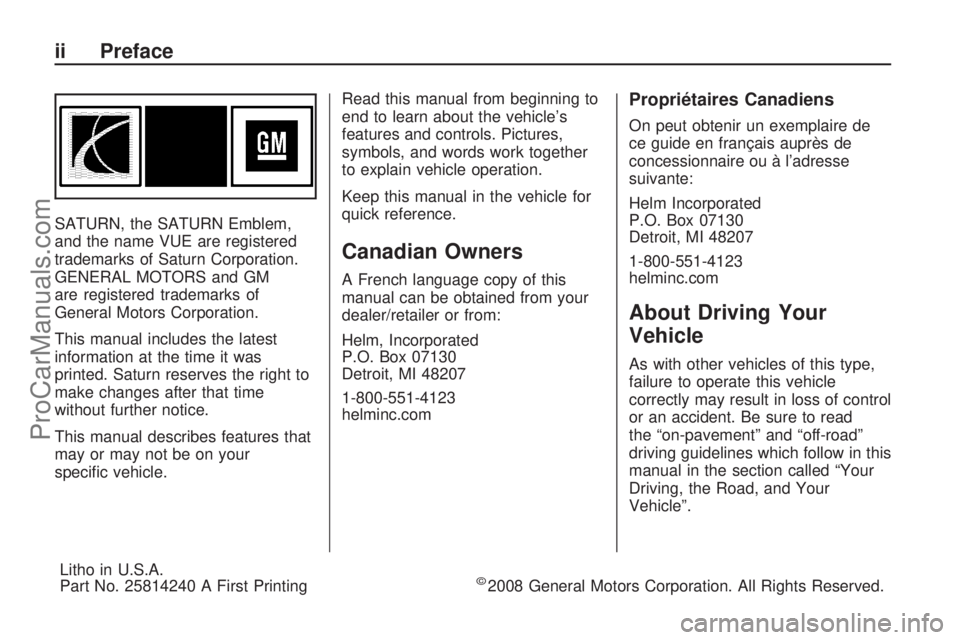
SATURN, the SATURN Emblem,
and the name VUE are registered
trademarks of Saturn Corporation.
GENERAL MOTORS and GM
are registered trademarks of
General Motors Corporation.
This manual includes the latest
information at the time it was
printed. Saturn reserves the right to
make changes after that time
without further notice.
This manual describes features that
may or may not be on your
speci�c vehicle.Read this manual from beginning to
end to learn about the vehicle’s
features and controls. Pictures,
symbols, and words work together
to explain vehicle operation.
Keep this manual in the vehicle for
quick reference.
Canadian Owners
A French language copy of this
manual can be obtained from your
dealer/retailer or from:
Helm, Incorporated
P.O. Box 07130
Detroit, MI 48207
1-800-551-4123
helminc.com
Propriétaires Canadiens
On peut obtenir un exemplaire de
ce guide en français auprès de
concessionnaire ou à l’adresse
suivante:
Helm Incorporated
P.O. Box 07130
Detroit, MI 48207
1-800-551-4123
helminc.com
About Driving Your
Vehicle
As with other vehicles of this type,
failure to operate this vehicle
correctly may result in loss of control
or an accident. Be sure to read
the “on-pavement” and “off-road”
driving guidelines which follow in this
manual in the section called “Your
Driving, the Road, and Your
Vehicle”.
ii Preface
Litho in U.S.A.
Part No. 25814240 A First Printing©2008 General Motors Corporation. All Rights Reserved.
ProCarManuals.com
Page 3 of 346
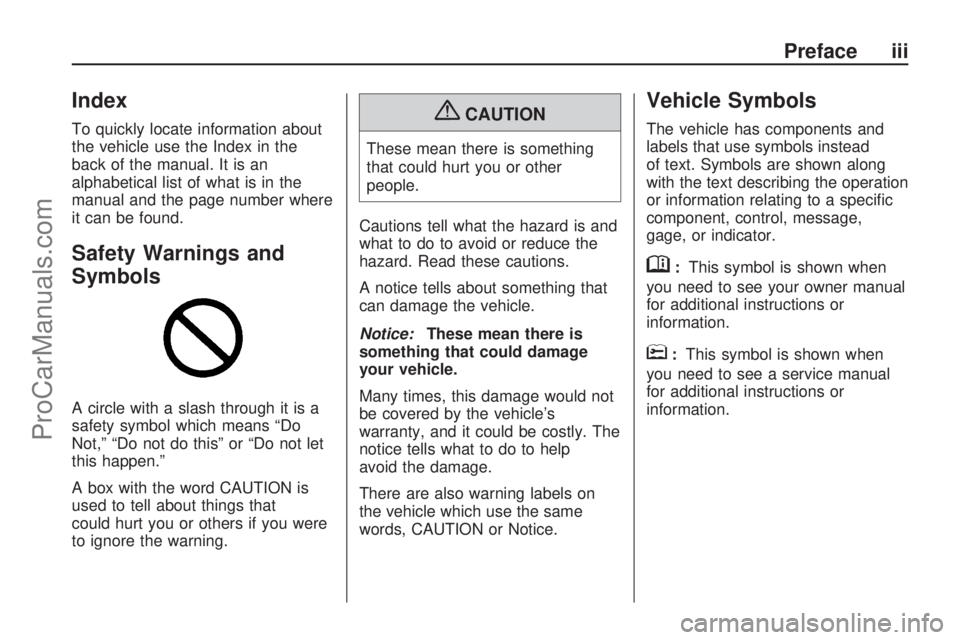
Index
To quickly locate information about
the vehicle use the Index in the
back of the manual. It is an
alphabetical list of what is in the
manual and the page number where
it can be found.
Safety Warnings and
Symbols
A circle with a slash through it is a
safety symbol which means “Do
Not,” “Do not do this” or “Do not let
this happen.”
A box with the word CAUTION is
used to tell about things that
could hurt you or others if you were
to ignore the warning.
{CAUTION
These mean there is something
that could hurt you or other
people.
Cautions tell what the hazard is and
what to do to avoid or reduce the
hazard. Read these cautions.
A notice tells about something that
can damage the vehicle.
Notice:These mean there is
something that could damage
your vehicle.
Many times, this damage would not
be covered by the vehicle’s
warranty, and it could be costly. The
notice tells what to do to help
avoid the damage.
There are also warning labels on
the vehicle which use the same
words, CAUTION or Notice.
Vehicle Symbols
The vehicle has components and
labels that use symbols instead
of text. Symbols are shown along
with the text describing the operation
or information relating to a speci�c
component, control, message,
gage, or indicator.
M:This symbol is shown when
you need to see your owner manual
for additional instructions or
information.
*:This symbol is shown when
you need to see a service manual
for additional instructions or
information.
Preface iii
ProCarManuals.com
Page 4 of 346
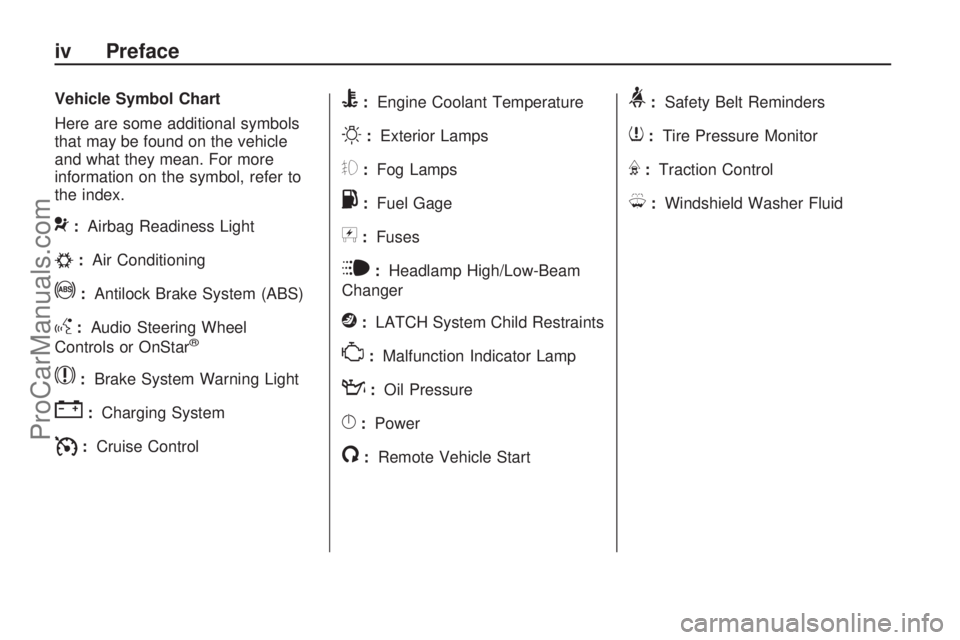
Vehicle Symbol Chart
Here are some additional symbols
that may be found on the vehicle
and what they mean. For more
information on the symbol, refer to
the index.
9:Airbag Readiness Light
#:Air Conditioning
!:Antilock Brake System (ABS)
g:Audio Steering Wheel
Controls or OnStar®
$:Brake System Warning Light
":Charging System
I:Cruise Control
B:Engine Coolant Temperature
O:Exterior Lamps
#:Fog Lamps
.:Fuel Gage
+:Fuses
i:Headlamp High/Low-Beam
Changer
j:LATCH System Child Restraints
*:Malfunction Indicator Lamp
::Oil Pressure
}:Power
/:Remote Vehicle Start
>:Safety Belt Reminders
7:Tire Pressure Monitor
F:Traction Control
M:Windshield Washer Fluid
iv Preface
ProCarManuals.com
Page 5 of 346

Seats and
Restraint System
Head Restraints
Head Restraints..................1-2
Front Seats
Manual Seats.....................1-3
Seat Height Adjuster...........1-4
Power Seat........................1-4
Manual Lumbar..................1-5
Heated Seats.....................1-5
Reclining Seatbacks...........1-5
Passenger Folding
Seatback...........................1-7
Rear Seats
Split Folding Rear Seat......1-9
Safety Belts
Safety Belts: They Are
for Everyone...................1-10
How to Wear Safety
Belts Properly..................1-13
Lap-Shoulder Belt.............1-17
Safety Belt Use During
Pregnancy.......................1-22
Safety Belt Extender.........1-22
Child Restraints
Older Children..................1-22
Infants and Young
Children..........................1-25
Child Restraint Systems. . . .1-27
Where to Put the
Restraint.........................1-29
Lower Anchors and
Tethers for Children
(LATCH)
..........................1-31
Securing a Child
Restraint in a Rear
Seat Position
...................1-36
Securing a Child
Restraint in the Right
Front Seat Position
.........1-38
Airbag System
Airbag System..................1-41
Where Are the Airbags?. . .1-44
When Should an Airbag
In�ate?............................1-45
What Makes an Airbag
In�ate?............................1-47
How Does an Airbag
Restrain?........................1-47
What Will You See After
an Airbag In�ates?..........1-48
Passenger Sensing
System............................1-49
Servicing Your
Airbag-Equipped
Vehicle
............................1-54
Adding Equipment to
Your Airbag-Equipped
Vehicle
............................1-55
Restraint System Check
Checking the Restraint
Systems..........................1-56
Replacing Restraint
System Parts After a
Crash
..............................1-57
Seats and Restraint System 1-1
ProCarManuals.com
Page 6 of 346
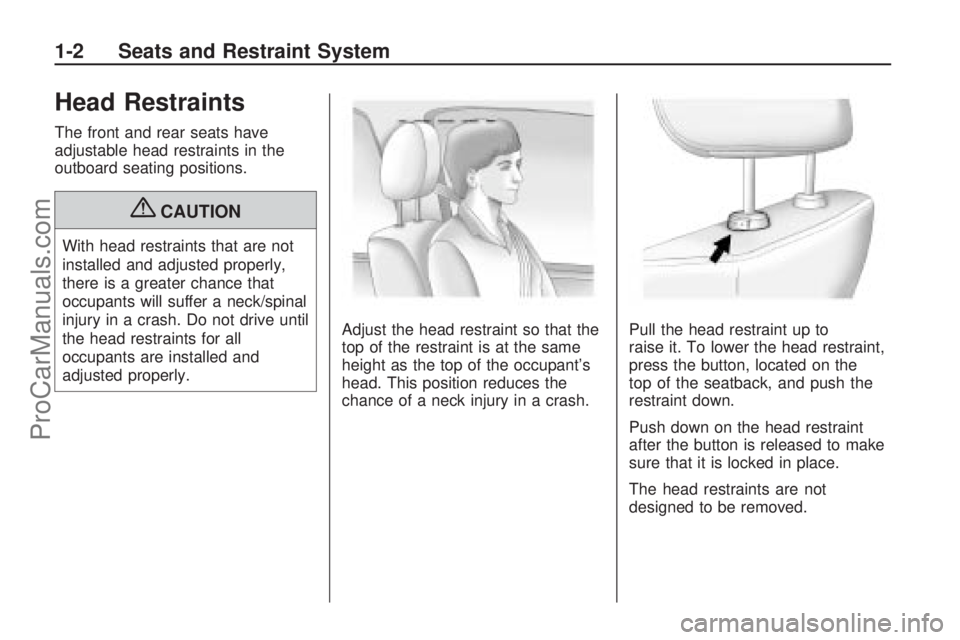
Head Restraints
The front and rear seats have
adjustable head restraints in the
outboard seating positions.
{CAUTION
With head restraints that are not
installed and adjusted properly,
there is a greater chance that
occupants will suffer a neck/spinal
injury in a crash. Do not drive until
the head restraints for all
occupants are installed and
adjusted properly.Adjust the head restraint so that the
top of the restraint is at the same
height as the top of the occupant’s
head. This position reduces the
chance of a neck injury in a crash.Pull the head restraint up to
raise it. To lower the head restraint,
press the button, located on the
top of the seatback, and push the
restraint down.
Push down on the head restraint
after the button is released to make
sure that it is locked in place.
The head restraints are not
designed to be removed.
1-2 Seats and Restraint System
ProCarManuals.com
Page 7 of 346
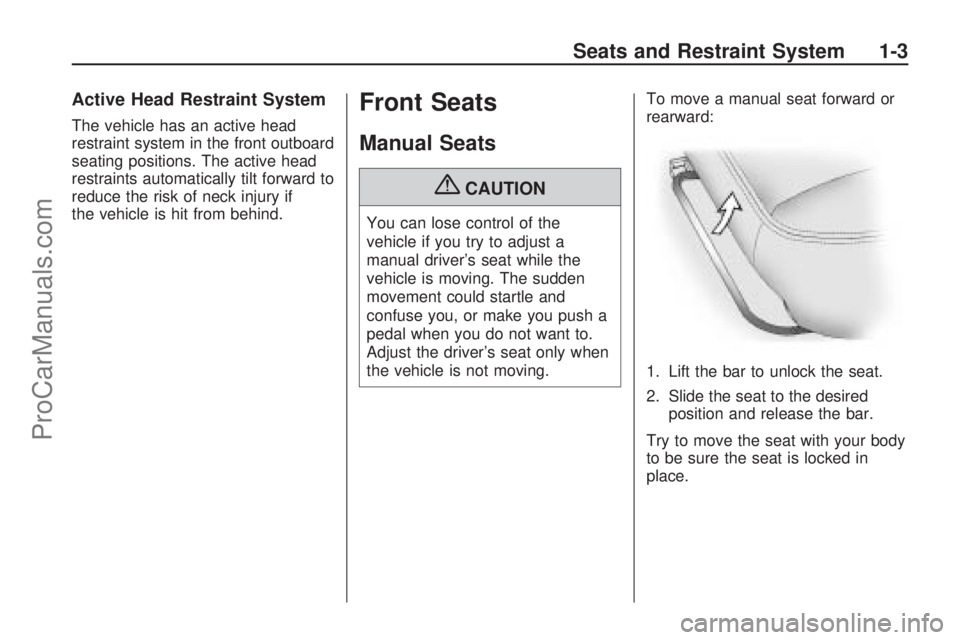
Active Head Restraint System
The vehicle has an active head
restraint system in the front outboard
seating positions. The active head
restraints automatically tilt forward to
reduce the risk of neck injury if
the vehicle is hit from behind.
Front Seats
Manual Seats
{CAUTION
You can lose control of the
vehicle if you try to adjust a
manual driver’s seat while the
vehicle is moving. The sudden
movement could startle and
confuse you, or make you push a
pedal when you do not want to.
Adjust the driver’s seat only when
the vehicle is not moving.To move a manual seat forward or
rearward:
1. Lift the bar to unlock the seat.
2. Slide the seat to the desired
position and release the bar.
Try to move the seat with your body
to be sure the seat is locked in
place.
Seats and Restraint System 1-3
ProCarManuals.com
Page 8 of 346
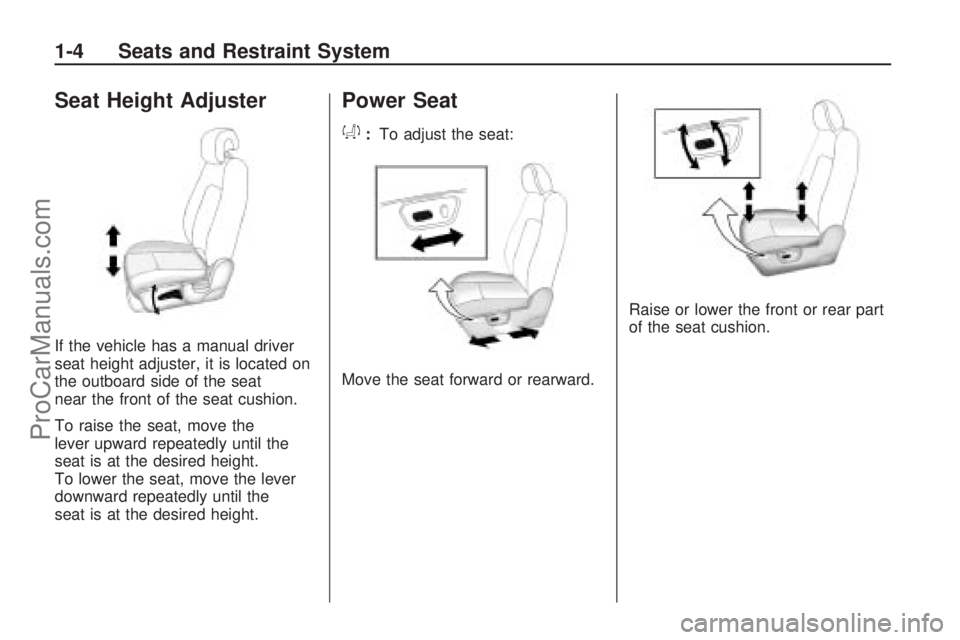
Seat Height Adjuster
If the vehicle has a manual driver
seat height adjuster, it is located on
the outboard side of the seat
near the front of the seat cushion.
To raise the seat, move the
lever upward repeatedly until the
seat is at the desired height.
To lower the seat, move the lever
downward repeatedly until the
seat is at the desired height.
Power Seat
a
:To adjust the seat:
Move the seat forward or rearward.Raise or lower the front or rear part
of the seat cushion.
1-4 Seats and Restraint System
ProCarManuals.com
Page 9 of 346
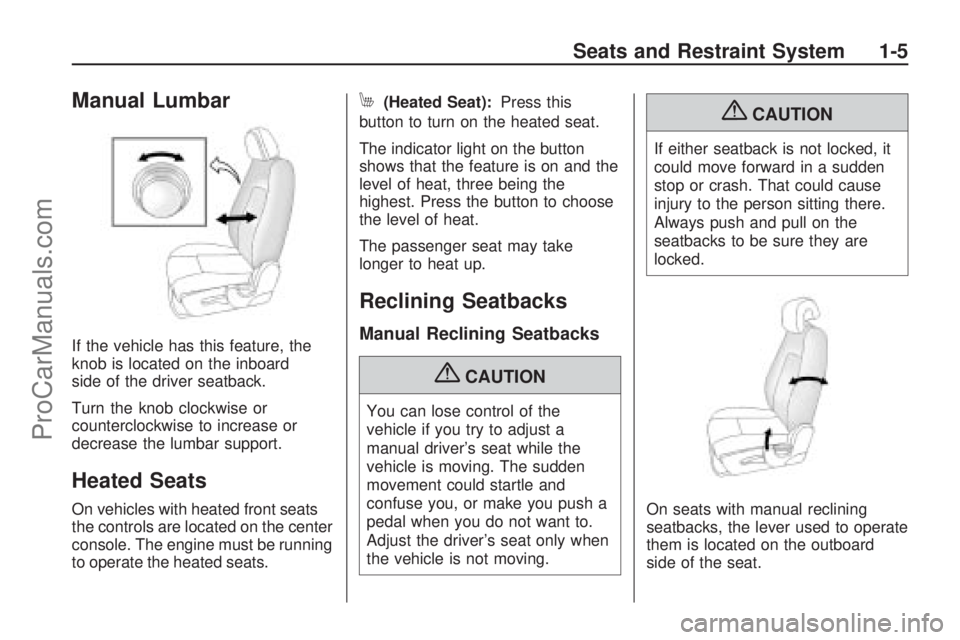
Manual Lumbar
If the vehicle has this feature, the
knob is located on the inboard
side of the driver seatback.
Turn the knob clockwise or
counterclockwise to increase or
decrease the lumbar support.
Heated Seats
On vehicles with heated front seats
the controls are located on the center
console. The engine must be running
to operate the heated seats.
M(Heated Seat):Press this
button to turn on the heated seat.
The indicator light on the button
shows that the feature is on and the
level of heat, three being the
highest. Press the button to choose
the level of heat.
The passenger seat may take
longer to heat up.
Reclining Seatbacks
Manual Reclining Seatbacks
{CAUTION
You can lose control of the
vehicle if you try to adjust a
manual driver’s seat while the
vehicle is moving. The sudden
movement could startle and
confuse you, or make you push a
pedal when you do not want to.
Adjust the driver’s seat only when
the vehicle is not moving.
{CAUTION
If either seatback is not locked, it
could move forward in a sudden
stop or crash. That could cause
injury to the person sitting there.
Always push and pull on the
seatbacks to be sure they are
locked.
On seats with manual reclining
seatbacks, the lever used to operate
them is located on the outboard
side of the seat.
Seats and Restraint System 1-5
ProCarManuals.com
Page 10 of 346

To recline the seatback:
1. Lift the recline lever.
2. Move the seatback to the desired
position, then release the lever to
lock the seatback in place.
3. Push and pull on the seatback to
make sure it is locked.
To return the seatback to an upright
position:
1. Lift the lever fully without
applying pressure to the
seatback and the seatback
returns to the upright position.
2. Push and pull on the seatback to
make sure it is locked.Power Reclining Seatbacks
If the seats have power reclining
seatbacks, the control used to
recline them is located on the
outboard side of the seat.
To recline the seatback, tilt the
top of the control rearward.
To bring the seatback forward, tilt
the top of the control forward.
{CAUTION
Sitting in a reclined position when
your vehicle is in motion can be
dangerous. Even if you buckle up,
your safety belts cannot do their
job when you are reclined like this.
The shoulder belt cannot do its job.
In a crash, you could go into it,
receiving neck or other injuries.
The lap belt cannot do its job
either. In a crash the belt could go
up over your abdomen. The belt
forces would be there, not at your
pelvic bones. This could cause
serious internal injuries.
For proper protection when the
vehicle is in motion, have the
seatback upright. Then sit well
back in the seat and wear your
safety belt properly.
1-6 Seats and Restraint System
ProCarManuals.com